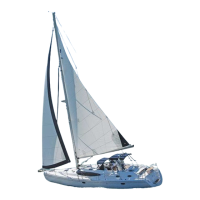nt
r
• Boatin
Safet
4.1
Where to Install Alarms
For minimum
rotection, C
alarms should be
installed near all sleepin
areas.
For maximum
rotection, C
alarms should be
installed in all sleepin
areas.
r
n
t t
n
t
rm
ot behind
urniture, drapes, closets, or areas that will
l
k
ir fl
w t
th
l
rm
ot within 12 inches o
window openin
s, exterior
doors, heatin
or return air vents, or an
other draft
.
The alarm should not be located within 5
1.5 m
feet
an
cookin
appliance.
For information on takin
care of
our C
alarm, see
the Maintenance chapter o
this manual.
imitations of the CO alarm:
arbon Monoxide alarms will not work without power.
ome examples causin
no alarm power are: A blown
r missin
use, broken wire,
ault
connection, circuit
breaker tripped, or a dischar
ed batter
This alarm will onl
detect the presence o
as at the
sensor.
arbon Monoxide
as ma
be present in other
.
arbon Monoxide alarms ma
not be heard. The alarm
ou
ness
s
es
ne
to meet or excee
t
e re
u
a-
tor
standards. However, the alarm ma
not be heard i
l
rm
r
l
t
in r
m
t
l
ti
n
r
hin
l
oors.
e a
arm ma
not
e
ear
persons w
o are
hard o
hearin
, have consumed alcoholic bevera
es,
taken prescription or non-prescription medication, or
e
a
ru
s
This alarm is desi
ned to detect
arbon Monoxide
rom
an
source of combustion. It is not desi
ned to detect
smoke,
ire, or an
other
asses. The alarm ma
not
sound at low
arbon Monoxide levels. This product is
intended for use in ordinar
indoor locations of livin
spaces. It is not desi
ned to measure compliance with
ccupational
a
et
Health Administration
HA
com-
m
r
r
n
tr
t
n
r
.
n
v
w
t
m
problems ma
consider usin
warnin
devices which pro-
vide audible and visual si
nals
or levels under 30 PPM
ow else to protect
our famil
from Carbon Monoxide
nsure alarms are installed properl
.
are
ull
read and
follow ALL the instructions in this manual. Test
our unit
ver
week. Alarms that do not work, do not alert
ou to
the presence o
arbon Monoxide.
ake re
ular visual inspections o
all
uel burnin
equip-
ment includin
as water heaters, kitchen
as stoves,
space heaters,
as dr
ers, or other pilots. Check the
l
r
th
l
m
! Th
l
r
h
l
l
.
ake re
ular visual inspections o
the en
ine and
en-
rator exhaust s
stems. Cracked exhaust s
stems can
allow
arbon Monoxide to enter the livin
area.
rofessionall
maintain
our en
ine and
enerator.
Althou
h all
as en
ines and
enerators produce
arbon
onoxide, a poorl
tuned en
ine and
enerator will pro-
duce
reater amounts of Carbon Monoxide
.3 Other Dan
ers
.3.1 Weather
torms rarel
appear without advanced notice. Check
the weather
orecast be
ore
ou be
in a da
o
boatin
.
Be aware, however, that weather conditions can chan
e
rapidl
. If
ou have a marine radio, listen to the weather
reports issued b
the U.
.
oast
uard and others. I
ou
have a portable radio, keep it tuned to a station broad-
astin
frequent weather reports. Man
boatin
clubs fl
weather si
nals. Learn to reco
nize these si
nals and
listen to
our local forecasts before leavin
port
Your surroundin
s can also be a
ood indicator o
chan
-
in
weather conditions. Watch for chan
es in wind direc-
tion or cloud formations. There is no substitute for a
ood
understandin
o
weather conditions and what to do
wh
n th
w
th
r t
k
t
rn f
r th
w
r
.
a
e 4.15 will
ive
ou a look at the dan
ers o
Li
htnin
strikes, with an overview of
our protection area.
ther steps to
ollow to weather a storm include
nsure a
passen
ers
ave on t
e
r
s.
ecure all loose
ear.

